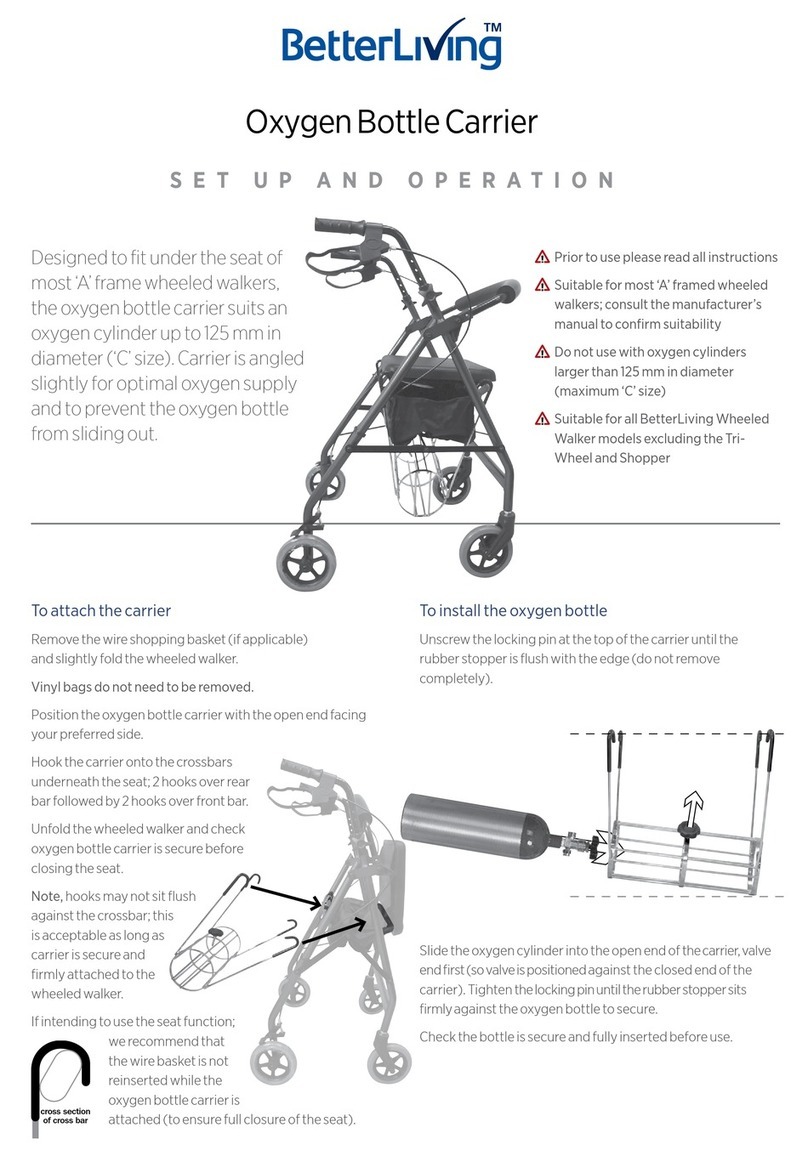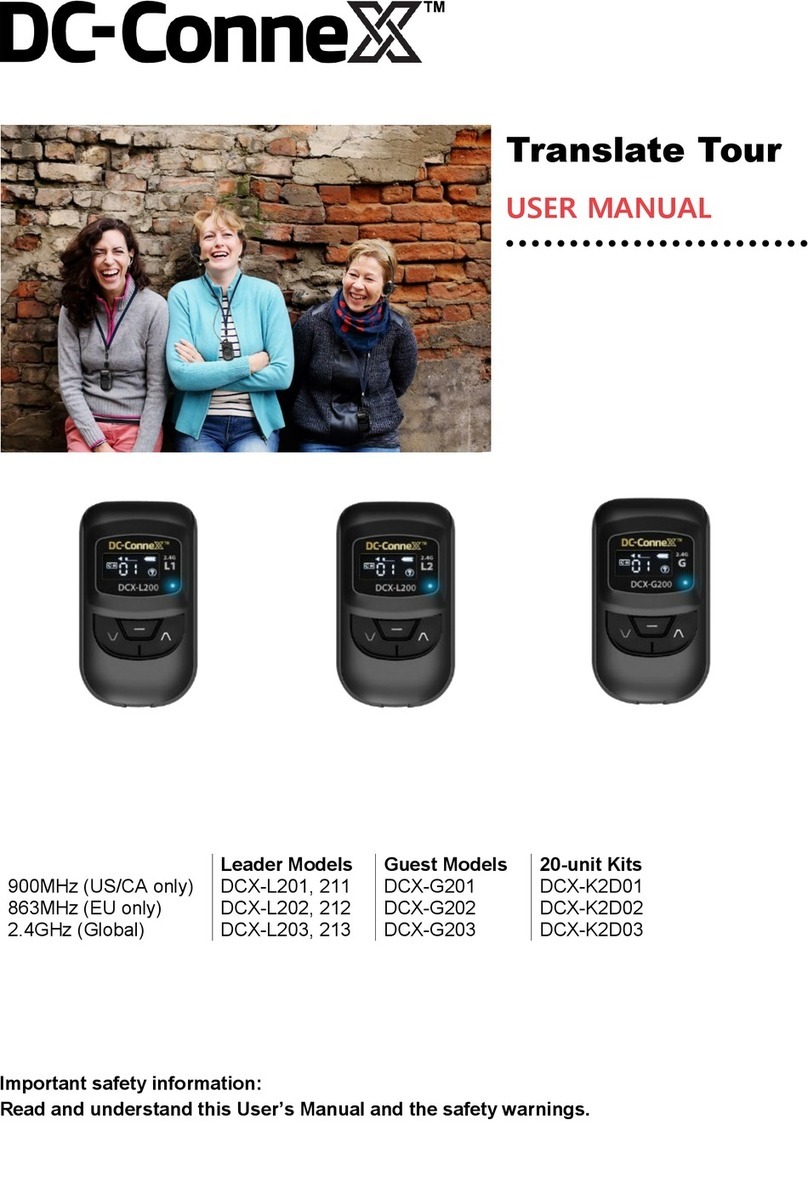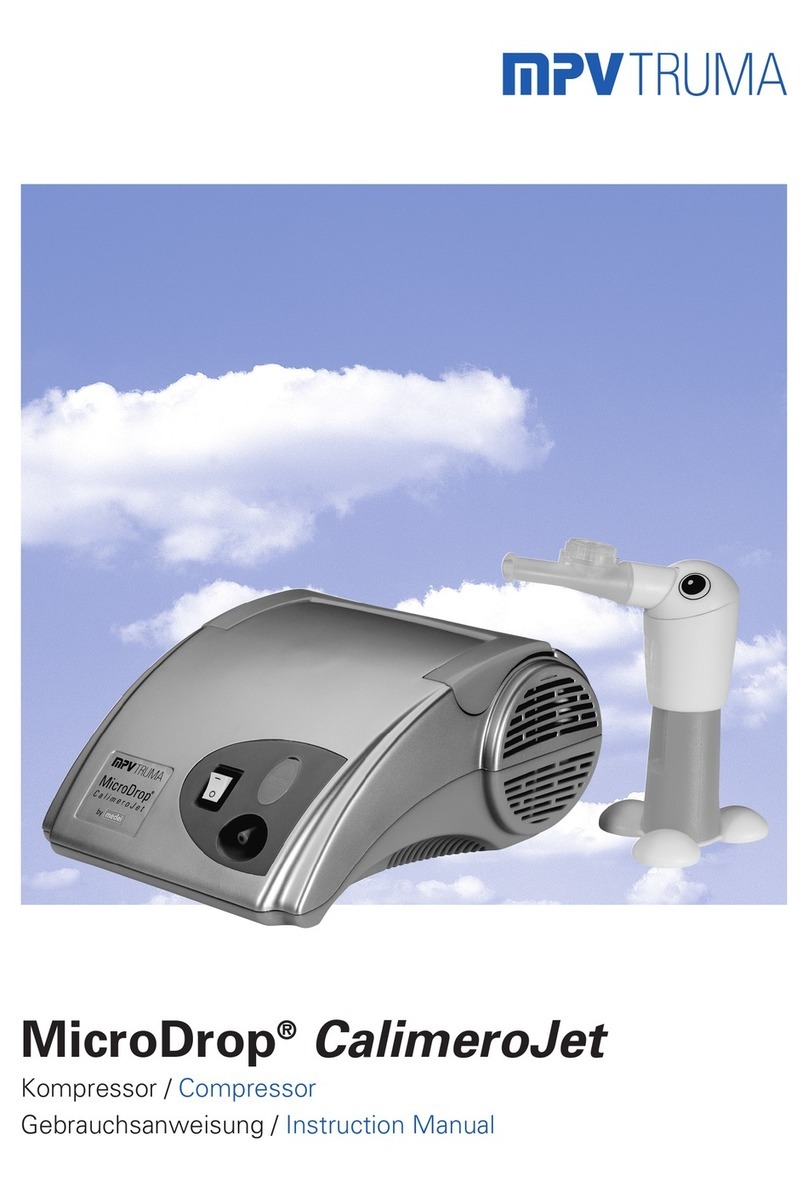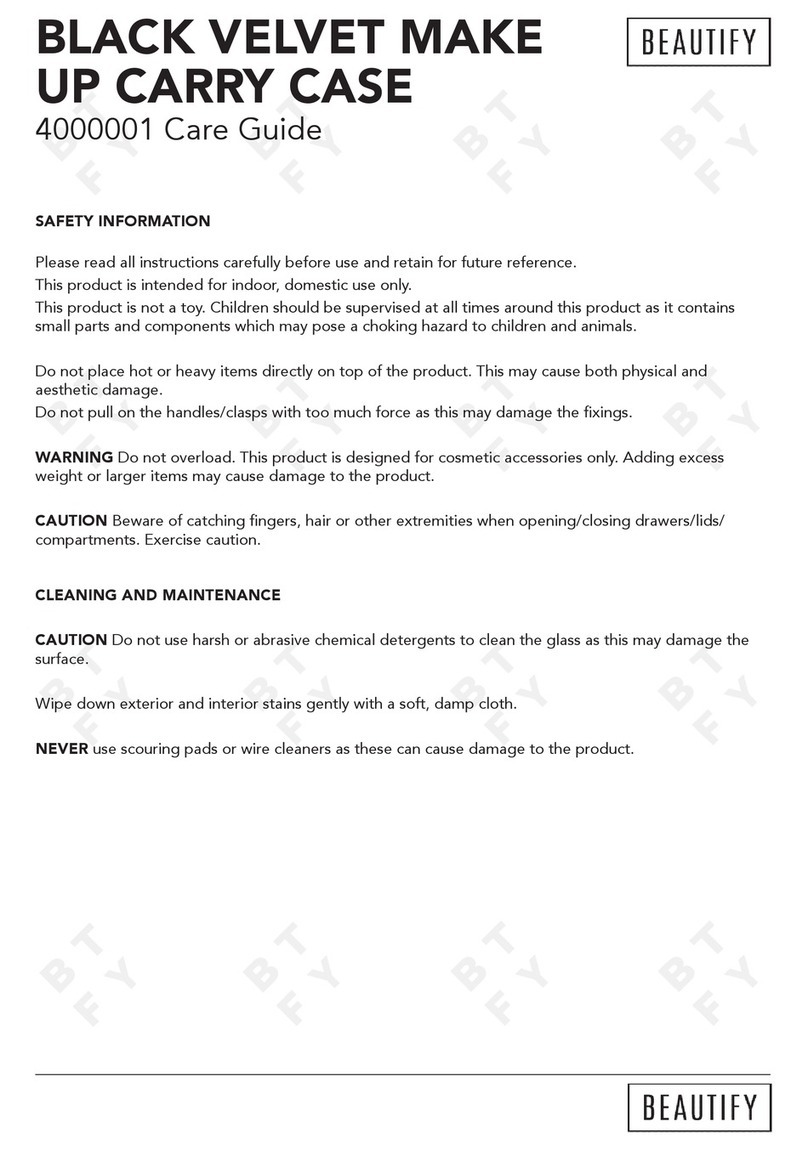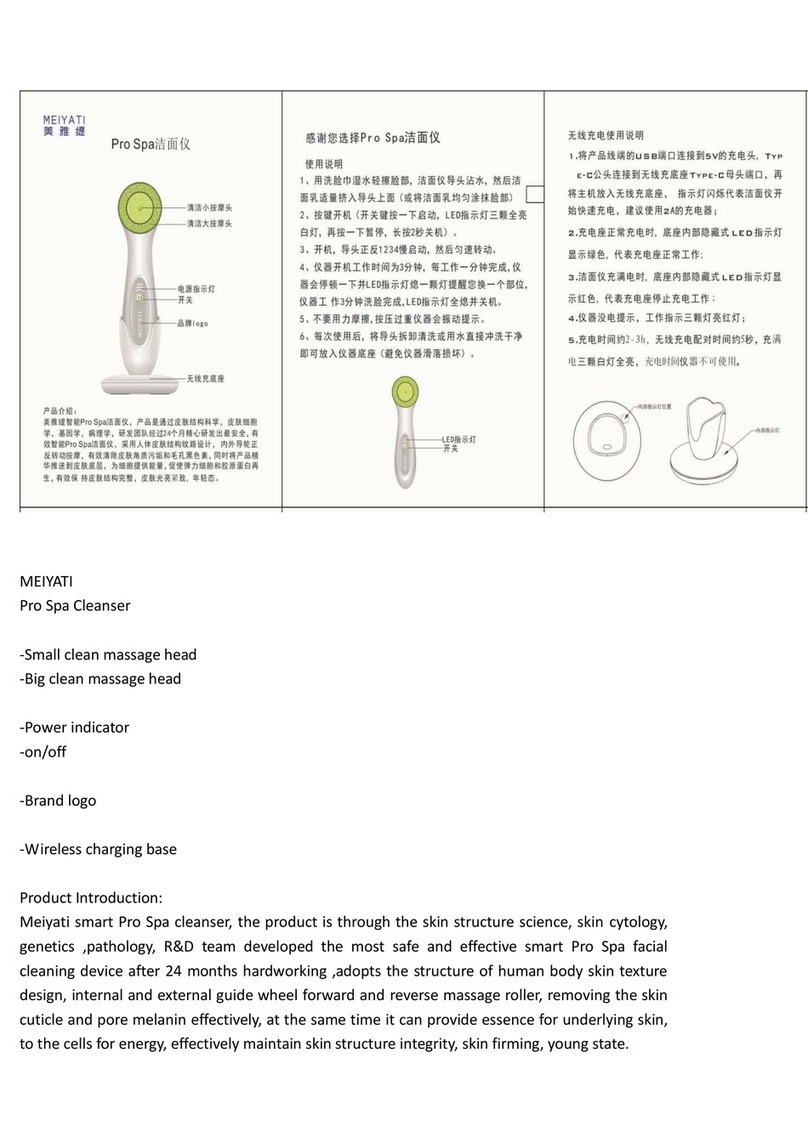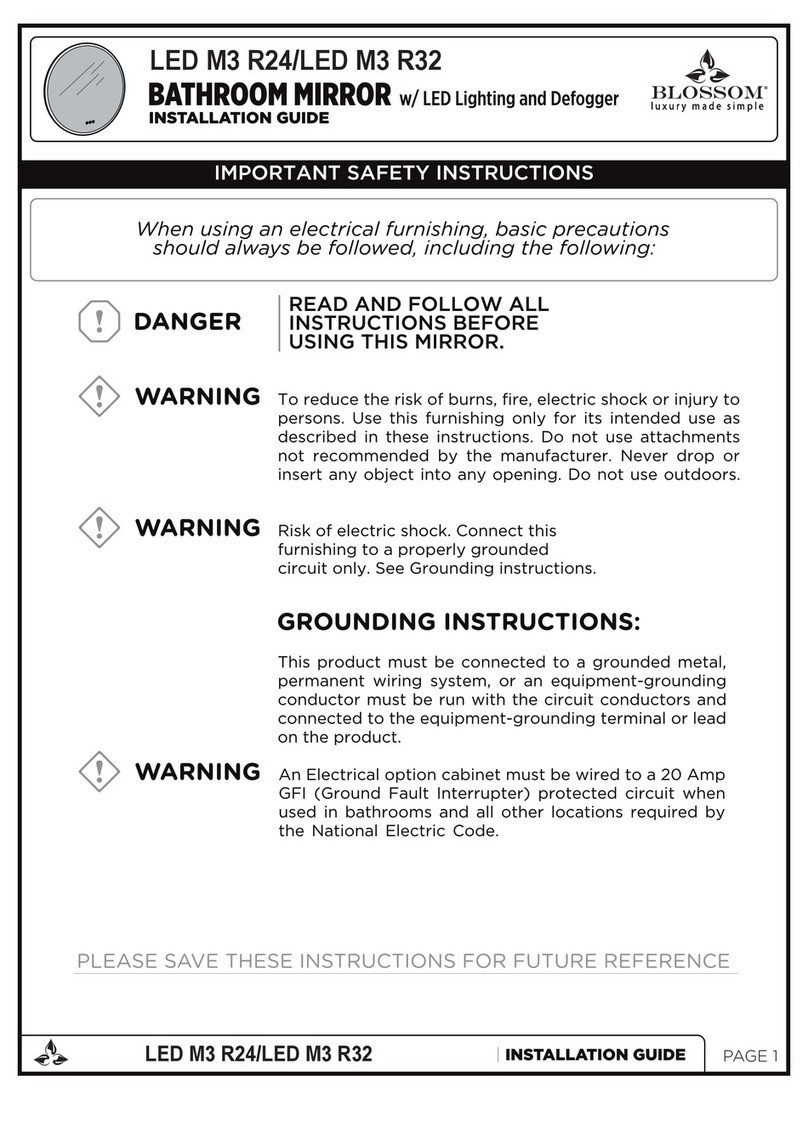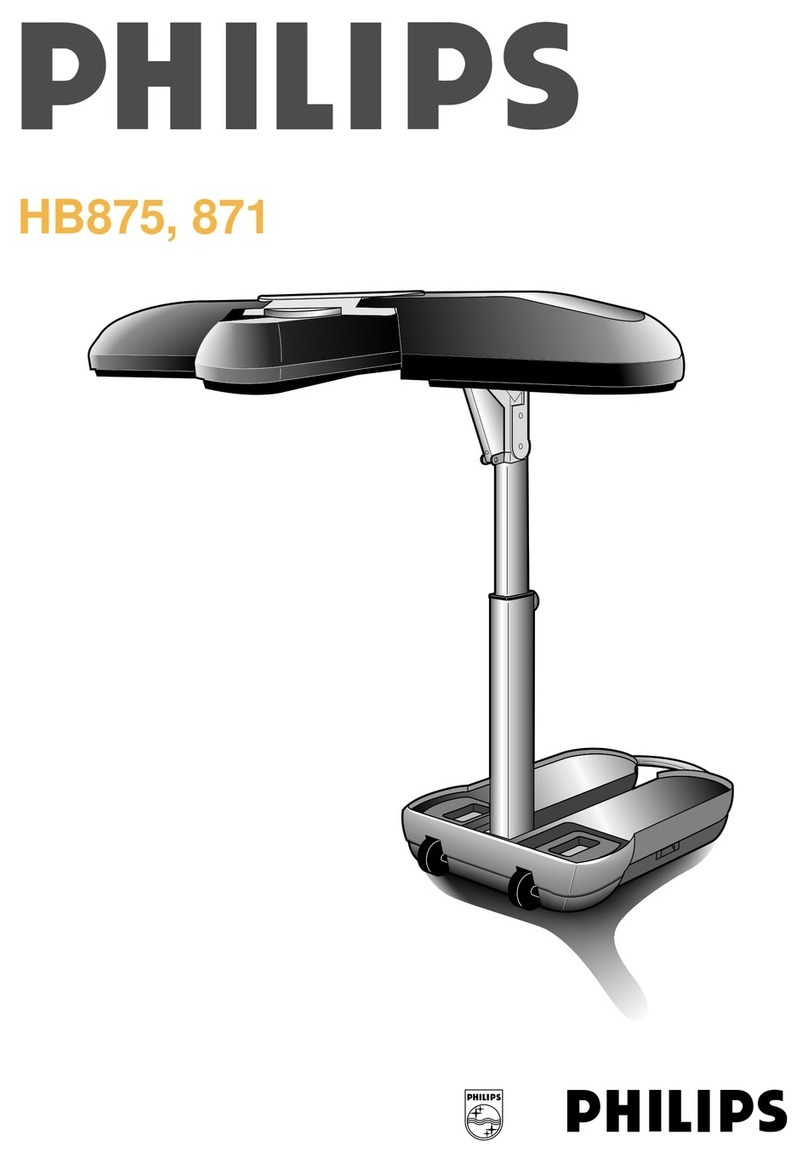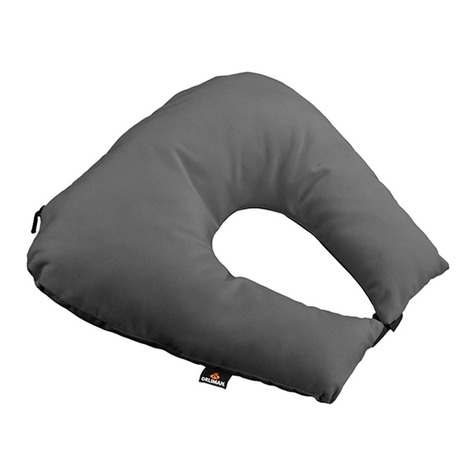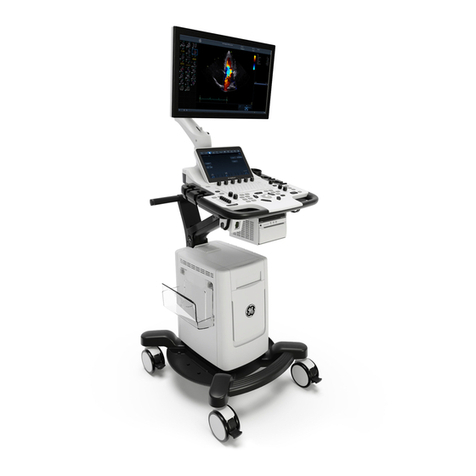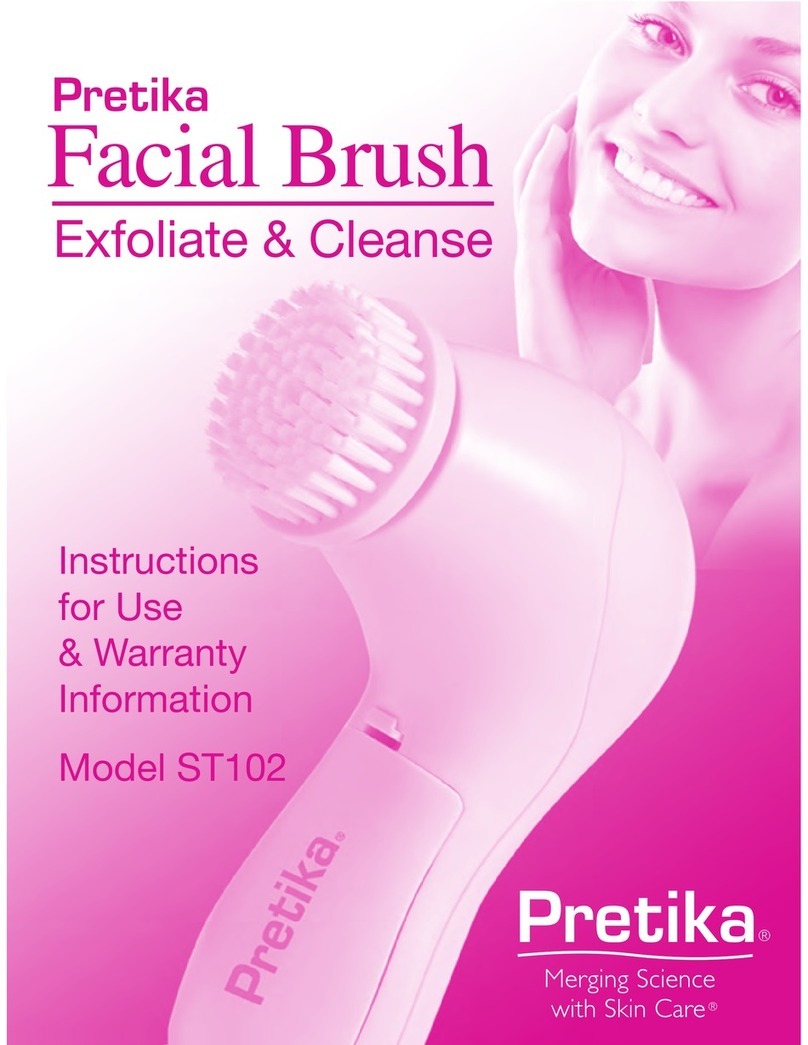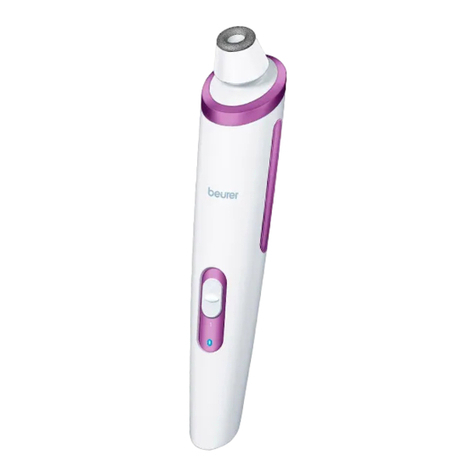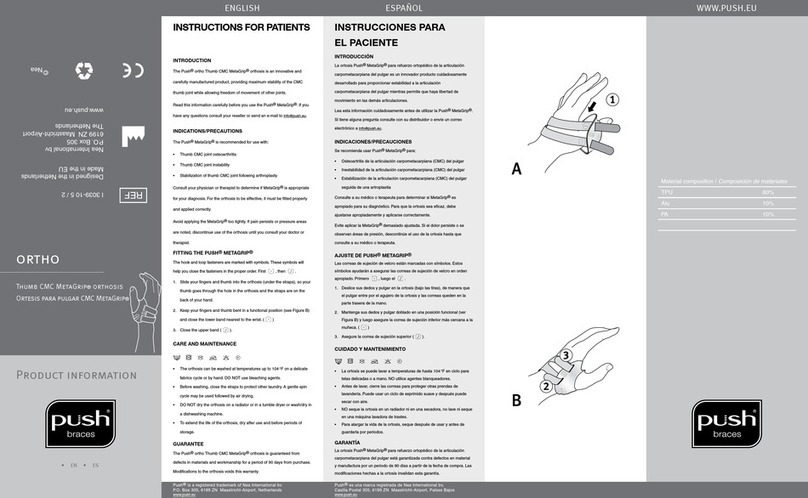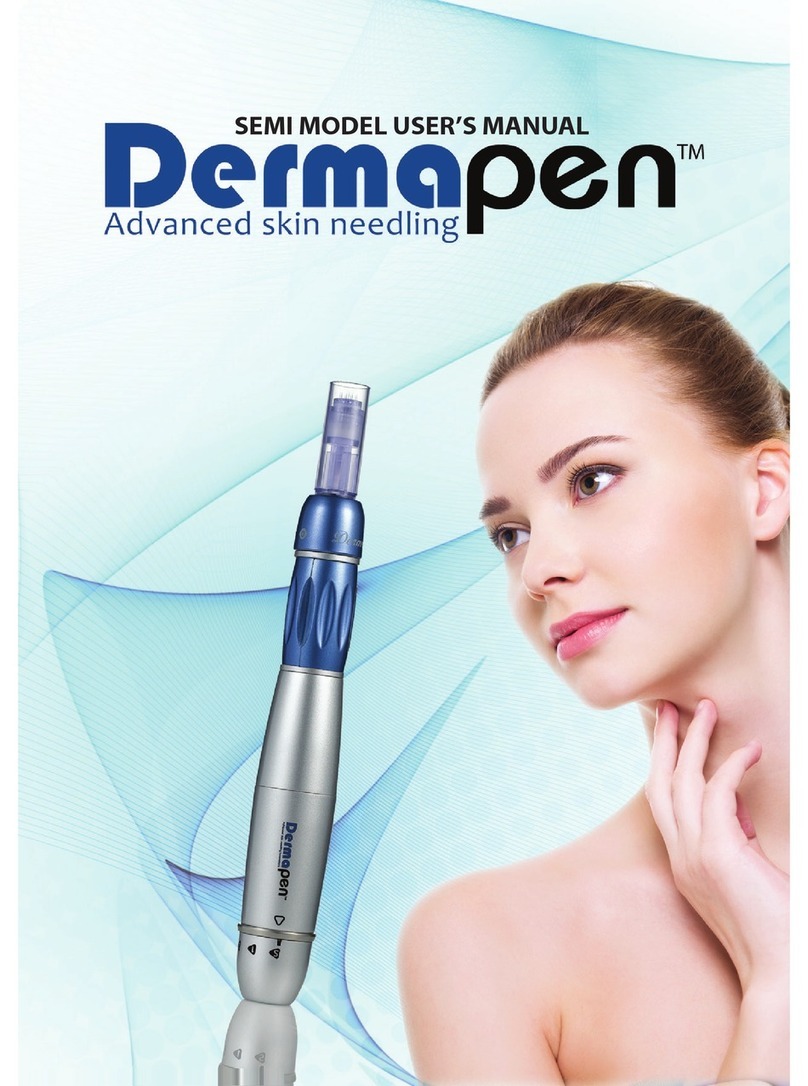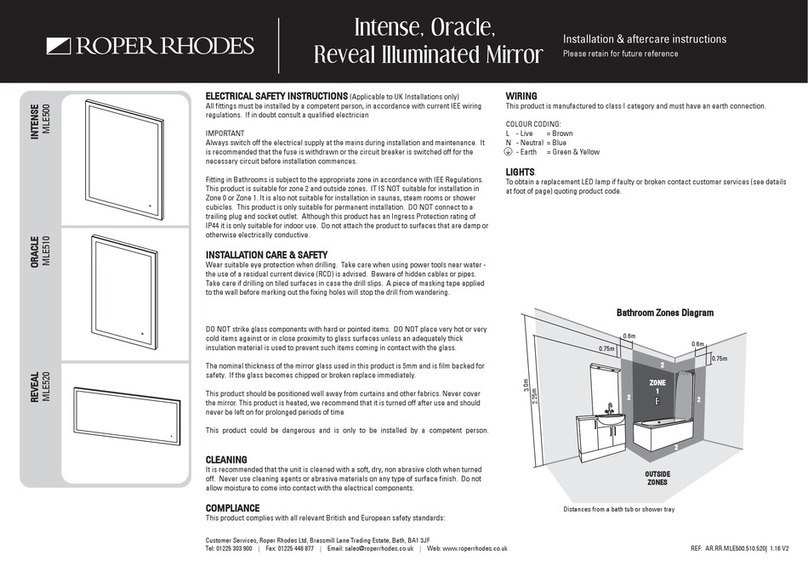Novis BetterLiving Mattress Replacement User manual

MATTRESS OVERLAY
Alternating Mattress Replacement / Overlay
USER GUIDE
MATTRESS REPLACEMENT

2
User Guide BetterLiving
Index
Overview page 3
Safety Precautions page 4
System Preparation page 6
Patient Set Up page 10
Operation page 11
Care and Cleaning page 14
Troubleshooting page 16
Technical Specifications page 18
Warranty page 22
Alternating Mattress Replacement / Overlay
Important Notice
Before operating this medical equipment, it is
important to read this manual and understand
the operating instructions and safety
precautions. Failure to do so could result in
patient injury and/or damage to the product.
We recommend you keep the manual near the
product.
Therapeutic devices and/or medical equipment
should only be used in accordance with
manufacturer’s instructions and under the
consent, supervision and management of a
suitably qualified health professional.
If you have any questions, please contact Novis
Healthcare on 1300 738 885.
Novis Healthcare has a policy of continuous
product improvement and reserves the
right to amend specifications presented in
this guide. Information correct at time of
production (October 2017) .
© 2017 Novis Healthcare. All rights reserved.
Definitions of Symbols Used
The following symbols may appear in this
manual, on the product, or on its accessories.
Some of the symbols represent standards and
compliances associated with the control unit
and its use.
Important Information
Caution
Electrical Hazard
Infection Control
Do Not...
Class II Protection against Electric Shock
Type BF Applied Part
~Alternating Current
Manufacturer
Manufacturing Date
Serial Number
Refer to Manual
Disposal: Do not dispose of this product
as unsorted municipal waste. Collection
of such waste separately for special
treatment is necessary.
IP21
Protection against foreign object
and vertically falling water drops.

3BetterLiving User Guide
Product Overview
TheBetterLivingalternatingpressure surfaces
aredesignedfor theprevention and treatment
ofskin breakdown and pressure injuries.
The Alternating Pressure Mattress
Replacement is designed to replace an
existing bed mattress, on either a standard or
profiling electric bed frame, as a solution for
people at risk to high risk of pressure injuries.
TheAlternatingPressure Mattress Overlay is
designed for use ontopof theexisting standard
bed mattress (or suitableunderlay)as asolution
forpeople at risk orlowriskof pressureinjuries.
The systems are constructed from transverse
air cells that cyclically inflate and deflate
in an alternating pattern, providing gentle
and dynamic support. Cyclic alternation
of pressure prevents arterial and venous
capillary occlusion in the patient’s surface
tissue – maintaining and stimulating the
flow of blood and lymphatic fluids through
these tissues to provide essential oxygen and
remove metabolic waste.
The system consists of the following
components:
¥Mattress Replacement/Overlay with
umbilical air hoses and CPR release
¥Control unit
¥Power cord
¥User guide
¥Carry bag
It is recommended that all packing
materials and manuals be kept in the carry
bag provided, for ease of storage and/or
transport.
Intended Use
¥The preventionand treatmentof skin breakdown
and pressure injuries in patients at risk to high
risk (replacement) or at risk to low risk (overlay).
Contraindications
Patient conditions for which the application of
pressure therapy on the BetterLiving systems
contraindications include:
¥Instable spinal cord injury
¥Cervical traction
Intended Care Setting
¥Aged care
¥Home care
Working Environment
¥Temperature: 15°C to 35°C (59° F to 95° F)
¥Humidity: 30% to 75% non-condensing
Shipping / Storage Environment
¥Temperature: 5°C to 60°C (41° F to 140° F)
¥Humidity: 30% to 90% non-condensing
Connecting to other devices
There no are other devices necessary for normal
operation. The control unit can be fitted to the foot
board of most hospital or aged care beds.
Therapeutic devices should only be used in
accordance with manufacturer’s instructions and
under the consent, supervision and management
of a suitably qualified health professional.
Novis Healthcare accepts no liability for any use,
change or assembly of the product other than that
stated in this User Guide. Refer to our Warranty
Statement for more details.
Overview

4
User Guide BetterLiving
Safety Precautions
The purpose of the following safety precautions
are to direct attention to possible dangers. The
safety symbols and their explanations require
careful attention and understanding.
The safety warnings by themselves do not
eliminate any danger. The instructions or
warnings they give are not substitutes for
proper accident prevention measures.
Foryourown safetyand thesafetyofequipment,
always take the following precautions.
General Safety Precautions
Read all instructions before using this
medical device
This system must be used on top of an
appropriate sized bed frame and the
appropriate operating environment as
stated in this manual.
Do not place the overlay directly on the
bed frame; designed for use on mattress.
Before commencing set up or installation,
ensure the power is switched o
and disconnect the power cord from
the control unit. Novis Healthcare
recommends using the cord retention
loops on either side of the mattress
replacement where possible and
attaching it to an electrical outlet
by the head of the bed.
Minimise layers between patient and
mattress and secure bed sheets loosely
so as not to aect the alternating cell
movement. As part of a sensible pressure
injury prevention strategy, avoid wearing
clothing that may cause areas of localised
damage due to creases, seams, objects in
pockets, etc.
Never use sharp objects or electrically
heated blankets on or under the system.
Product top cover may present a
suocation risk. It is the responsibility of
the caregiver to ensure that the patient can
use this product safely.
Avoid blocking the air intakes of the
control unit, located at the rear of the unit.
Do not place items such as blankets over
the control unit.
Bed frames used with the systems can
vary greatly depending on the specific
healthcare setting (ie hospitals, aged care,
home care, etc). It is the responsibility
of the caregiver to take the necessary
precautions to ensure the safety of the
patient. This includes, but is not limited to,
the appropriate use of side rails to prevent
falls.
Only the control unit and mattress
combination as indicated by Novis
Healthcare should be used, otherwise the
correct function of the product cannot be
guaranteed.
User Capacity
The maximum recommended patient
weight is 180 kilograms for the Mattress
Replacement and 150 kilograms for the
Mattress Overlay.
The minimum recommended patient
weight is 40 kilograms for both the Mattress
Replacement and Mattress Overlay.
Do not exceed this safe working load or
you risk injury to the patient or carer and
damage to the product.

5BetterLiving User Guide
Safety Precautions
Protection Against Hazards
Fluids
Avoid spilling fluids on any part of the control
unit. If spills do occur:
¥Turn o control unit power and disconnect
the unit from the mains electricity supply.
¥Immediately clean fluids from the casing by
wiping with a soft cloth.
Ensure there is no moisture in or near the
power inlet, power switch and power cord
before reconnecting the power supply.
Check the operation of controls and other
components around the spill area.
Fluid or liquid remaining on the electronic
controls can cause corrosion that may
cause the electronic components to fail.
Component failures may cause the unit
to operate erratically, possibly producing
potential hazards to patient and carers.
Explosion Hazard
Equipment is not suitable for use in the
presence of a flammable anaesthetic mixture
with air, oxygen or nitrous oxide.
¥Do not use in the presence of smoking
materials or open flame –
air flowing through the mattress will support
combustion.
¥Do not open the control unit – risk of
electrical shock. Refer servicing to qualified
service personnel.
Disposal
Dispose of all components (control unit
including batteries, air filter, air cells, mattress
cover and base) according to local procedures
and regulations or contact Novis Healthcare for
advice.
Power Cord
The system should never be operated with a
worn or damaged power cord. Keep the cord
away from heated surfaces. Should the power
cord be found to be worn or damaged, contact
Novis Healthcare for a replacement.
Interference
Although this equipment conforms to the
intent of directive IEC 60601-1-21in relation to
Electromagnetic Compatibility, all electrical
equipment may produce interference. If
interference is suspected, move equipment
away from sensitive devices or contact Novis
Healthcare.
1IEC 60601-1-2. Medical Electrical Equipment - Part 1: General
Equipments for Safety, Amendment No. 2. Collateral
Standard. Electromagnetic Compatibility Requirements and
Test).

6
User Guide BetterLiving
System Preparation
Carefully unpack the system and inspect each item for any damage that may have occurred during
transit and handling. Any damage or missing components should be reported to Novis Healthcare
as soon as possible.
Confirm there are no sharp objects in the immediate area
which may risk damage to the mattress replacement. Bed Base
Umbilical Cord
Foot Symbol
Attach to the bed by securing the adjustable
straps, located on the underside of the mattress
base under each bed end. On a profiling bed,
secure the straps around the moveable sections
of the base. Ensure the buckles are securely
fastened and straps are pulled tight.
Mattress Replacement
Remove the existing mattress and place
the mattress replacement on top of the
bed frame.
Printed top cover facing upwards and
umbilical cord towards the base of the bed.

7BetterLiving User Guide
System Preparation
Bed Base
Umbilical Cord
Foot Symbol
Secure to the bed by sliding the elastic straps,
located on the underside of the mattress
overlay, around each end of the existing
mattress. Ensure the straps fit firmly, and are
not twisted or pulled towards the corners.
Mattress Overlay
Remove all bedding from the mattress and
place the mattress overlay on the existing
mattress (or suitable foam underlay).
Printed top cover facing upwards and
umbilical hose towards the base of the bed.
Check CPR sealing valve is closed – the
turning tab and the four holes must be
aligned to ‘CLOSED’ position.
Do not secure mattress straps to bed side rails – straps will tear.
Ensure that straps do not interfere with the operation of the bed, and that the mattress is
properly secured. Failure to do so could result in patient injury or equipment damage.

8
User Guide BetterLiving
System Preparation
Hang the control unit over the foot end of the
bed, using the in-built spring loaded hanging
hooks. Pull the hooks by the rubber tabs to
prevent accidentally trapping your fingers.
Ensure it is secure before use; failure to do so
could result in equipment damage.
Connect the umbilical connectors to the
corresponding sockets on the side of the
control unit. Listen for a click as confirmation
the connector is locked in place.
Straighten any twists in the
umbilical air hoses.
Ensure the umbilical air hose is not
trapped between the mattress and bed.
Feed power cord through the cord retention
loops along either side of the mattress base.
Insert power cord base into the side of the
control unit, then plug into an appropriate
electrical outlet and switch on mains power.
The Power indicator will glow amber,
confirming the control unit is connected to a
power source.
Ensure the power cord is not under strain;
is free from obstruction; and is secured
safely so as not to be a trip hazard.

9BetterLiving User Guide
On the control unit, press and
hold the Power button for a
minimum of three seconds.
The Power indicator will
illuminate to indicate the
system is operational. While
reaching initial operating
pressure, all five pressure setting indicators will
flash green.
Allow up to 45
minutes for
the Mattress
Replacement and
20 minutes for the
Mattress Overlay.
Once operating pressure is reached, both
Alternate and Auto indicators will illuminate to
indicate both alternating mode and automatic
pressure setting are functioning.
Do not lie a person (or any weight) on the
mattress during initial inflation.
When initial inflation is complete, the
Pressure Setting and Max Inflate indicators
will extinguish, to indicate the system is
ready for use. The system automatically
defaults to Alternating Mode at start up.
Once the mattress is fully inflated, bedding can be
replaced. Secure sheets loosely enough to ensure they do
not interfere with cell alternation.
Place the patient on to the mattress replacement/overlay.
The system will automatically set an optimum pressure
for the patient’s weight and will continuously alternate
over a 12 minute cycle.
Perform a ‘bottoming out’ test (a test to ensure the
patient is adequately suspended away from the base),
refer to page 10.
System Preparation
3 SEC
REPLACEMENT
OVERLAY

10
User Guide BetterLiving
Patient Set Up
Pressure Setting
It is recomended that the Auto function remain active whenever possible. If Pressure Setting is
manually adjusted always perform a Bottoming Out Test as details below.
Bottoming Out Test
¥Check system is in alternation mode by ensuring the indicator above the Alternate button
is illuminated, and that one set of air cells is inflated while the other set is deflated.
You may need to unzip the cover to feel the cells for inflation.
¥With the patient lying supine, unzip one side of the top cover just past sacral region (lower
spine).
¥Slide your hand underneath the patient and feel for a deflated cell under the patient’s lower
spine. The inner static cell will remain inflated, however your hand should easily slide between
patient and base.
¥If your hand can pass under the patient, then patient is adequately suspended. If not, manually
adjust pressure to ‘firmer’ and wait at least one cycle (12 minutes) for pressure to increase before
repeating the test.
If manual pressure adjustment fails, press Max Inflate to force mattress to full inflation.
Wait at least one cycle (12 minutes) for pressure to reach maximum pressure, then press
Alternate to return to an alternation cycle. Wait at least one more cycle (12 minutes)
for pressure to increase before repeating the test.
We recommend repeating the Bottoming Out test at least
12 minutes after any manual pressure readjustment.

11 BetterLiving User Guide
Operation – Control Panel
MAX
INFLATE
PRESSURE SETTING
AUTO
SOFT FIRM
ALTERNATESTATIC MODE
POWER
3 SEC
3 SEC
ALARM MUTE
A
POWER FAIL
PRESSURE LOSS
PANEL LOCKOUT
HCBA D F GE
AMax Inflate
Rapidly inflates mattress to maximum pressure
in Static mode. System will automatically return
to Alternating mode after 20 minutes.
BPressure Setting
Allows manual adjustments to the automatic
pressure setting (within reasonable limits for
the patient’s detected weight). Press the button
to cycle from Soft to Firm pressure. Press the
button again to cycle back to Auto – green
indicator illuminates to indicate automatic
pressure setting is functioning.
C Mode
Cycle between Static and Alternating modes.
Press the button to select required mode –
indicator glows green above the selected mode
to indicate the mode currently active.
See Mode on page 12 for more details
D Power
Press and hold for a minimum of three seconds
to turn system power on and o.
Green light = power on.
E Alarm Mute
Turns audible alarm o temporarily. Press
to mute the alarm. Alarm will resound in 20
minutes if the issue has not been resolved, or
immediately if new fault detected.
FPower Failure
During a power failure, amber light flashes and
an audible alarm sounds to alert carer.
GPressure Loss
Indicates mattress has failed to reach required
pressure. Indicator flashes amber and after five
minutes, an audible alarm sounds to alert carers
that the control unit has failed to reach the set
pressure. Refer to Troubleshooting for support.
H Lock/Unlock
Lock and unlock the Control Unit panel to
prevent unwanted interference.
Press and hold the button for a minimum of
three seconds – a beep sounds and the light
illuminates to indicate system is locked. When
locked, only the Alarm Mute and Lock/Unlock
button remain operational.
Press again for at least three seconds to unlock
(beep sounds and light turns o).

12
User Guide BetterLiving
Operation
Mode
In Alternating Mode, alternate
mattress air cells inflate and
deflate following a fixed cycle time
of 12 minutes.
In Static Mode, all air cells remain
fully inflated. This mode should
be used to create a firm base for
stable patient handling and transport or other
special circumstances.
The system will automatically start in Static
Mode to initiate mattress inflation, and
revert to Alternating Mode once optimal
pressure is reached.
The system will operate in Static Mode for a
maximum of 20 minutes, after which it will
automatically revert to Alternating Mode
for patient safety.
The system provides no therapeutic
benefits when operating in Static Mode.
Transport
The mattress should be transported in static
mode, without control unit.
Press the Static button and wait 12 minutes to
ensure all air cells are inflated.
Before moving the mattress, ensure the control
unit is switched o and disconnected from
mains power. Disconnect the umbilical air hose
from the control unit by unplugging the quick
release connectors. Run the umbilical cord
through the left-side cord retention loops and
clip the male and female connectors around a
cord retention loop to secure in place.
ALTERNATE
STATIC
Quick Twist CPR
Rapid deflation of the mattress may be required
for emergency treatment (or to decommission
the unit). TheQuick TwistCPR valveis located at
the top of themattress, tothe rightofthe patient’s
head.
If emergency treatment isrequired, turn theCPR
valve tothe‘OPEN’ position.Thiswillrapidlydeflate
theentiresystem, including staticheadcells.
To re-inflate the system after the Quick Twist
CPR valve has been released, turn the tab to
the ‘CLOSED’ position, ensure control unit is
switched on and wait for the system to gain
optimal pressure.
CPR IN THE CLOSED POSITION.
TWIST IN EITHER DIRECTION TO OPEN
CPR IN THE OPEN POSITION.
TWIST IN EITHER DIRECTION TO CLOSE

13 BetterLiving User Guide
Operation
Deflation and Storage
Press the power button for a minimum of three
seconds to switch o the control unit.
Switch o mains power and unplug the power
cord from the mains outlet.
Turn the Quick Twist CPR to OPEN to release air
and deflate all cells.
Press the release buttons on the umbilical cord
connectors to release the air hoses.
Once air has been released from the system,
detach the mattress from the bed. Roll the
mattress from head end to foot end to remove
additional air from the system.
Unroll the mattress slightly and place the
control unit, power cord and umbilical cord on
the mattress to keep them protected.
Roll the mattress with the control unit and
power cord inside, and place all items in the
custom carry bag for safe keeping.

14
User Guide BetterLiving
Care and Cleaning
To prevent cross contamination, the mattress should be examined and disinfected between
patient use.
Clean the mattress in accordance with local infection control policy and government
regulations. Failure to do so could cause patient or personal injury.
The mattress is not protected against excessive amounts of fluid.
Switch o and disconnect the control unit from mains power supply before cleaning. Do not
immerse the control unit in fluid.
Do not use high temperature autoclave steam cleaning devices or phenolic based products
for cleaning. This could result in damage to the equipment and may result in damage to the
polyurethane coating, or negate the biocompatibility properties of the fabric.
Cleaning and Infection Control
It is recommended that the system is cleaned every two weeks if in constant use.
Base Cleaning
Swab the mattress base and cells with a solution of sodium hypochlorite or similar (up to 10,000
ppm available chlorine). Dry thoroughly before refastening.
Do not machine wash or tumble dry the air cells or mattress base.
If cleaning or disinfection is required, do not allow fluid to enter air cells and air hoses.
Top Cover Removal
Raise the waterfall skirt and locate the zippers
at the foot end of the mattress.
Starting with either zipper, run the zipper along
the side of the mattress towards the centre of
the head end.
Repeat with other zipper. The top cover can
now be detached from the mattress base.
Top Cover Cleaning
Unzip and remove the top cover from the base
before washing (refer right).
For basic care and cleaning, wipe down with
warm water containing PH neutral detergent.
The top cover can also be machine washed
at a maximum of 95° C (203° F) using neutral
detergents.
Refer to the top cover wash tag
for detailed cleaning instructions.
Do not use system without top cover.

15 BetterLiving User Guide
Care and Cleaning
Control Unit Cleaning
Disconnect control unit from mains power before cleaning. Gently wipe down the external case
with a soft cloth.
Soak the cloth in warm water containing mild PH neutral detergent, and wring any excess water
before gently wiping all external controls. Repeat the process with a dry cloth to remove excess
moisture. A soft bristled nylon brush can be used to gently clean crevices.
Ensure the control unit is disconnected from mains power before cleaning.
Do not spray disinfectant directly on to the control unit, or immerse the unit in water or other fluid.
Disinfection
The mattress, top cover and control unit may be decontaminated by a solution of sodium
hypochlorite or similar (up to 10,000 ppm available chlorine). Dry thoroughly before use.
For infection control, swab with a solution of sodium hypochlorite or similar (up to 10,000 ppm
available chlorine). Dry thoroughly before reattaching and use.

16
User Guide BetterLiving
Troubleshooting
SYMPTOM SOLUTION
Control unit does not
operate; no display lights
Check control unit is connected to the mains power supply.
Check for loose power cord connection and ensure main power is
switched on.
Check the fuse in rear panel of control unit. Replace if necessary.
Check condition of power cord and plug. Check if mains socket is
faulty.
Pressure Loss indicator
constantly illuminated;
mattress is not inflating
with control unit
connected and
switched on
Ensure the main power is turned on and power cord is connected
to mains and control unit.
Check control unit/mattress air connections are fitted securely,
and reconnect umbilical cord if loose.
Ensure control unit is turned on.
Check air intake from filter is not blocked by linen/dust. Replace
with new filter if needed.
Ensure the air cells are free of damage or leaks.
For faster mattress reinflation once the air leak has been closed, press MAX INFLATE and wait until
thePressure Loss indicator extinguishes. Press the MODE button to resume Alternation mode.
Control unit is making
unusual noise Ensure control unit is resting against a solid surface
Power Failure
Check control unit is connected to the mains power supply.
Check for loose connection on plug and main power is switched
on.
Check the fuses in control unit. Replace if necessary.
Check condition of power cord and plug. Check if mains socket is
faulty.
Patient is sinking or
‘bottoming out’ whilst lying
flat on the mattress
The pressure maybe set too low for the patient’s weight – increase
the pressure setting by cycling to a higher pressure setting on the
Pressure Setting button.
Check for air leaks in the mattress and air hoses.
If the problem persists, move patient to an alternate product and contact Novis Healthcare.

17 BetterLiving User Guide
Waste Disposal
This product has been supplied from an
environmentally aware manufacturer that
complies with the European Community’s
Waste Electrical and Electronic Equipment
Directive (WEEE).
This product may contain substances that
could be harmful to the environment if
disposed of in places (landfills) that are not
appropriate according the legislation. Please
be environmentally responsible and contact
your local authority on available options to
recycle this product at its end of life.
Service Life
The expected service life of a control unit and a
mattress is highly dependent on frequency of
use, servicing, care and maintenance.
To maintain the condition of the alternating
mattress system, service the system regularly
according to the schedule recommended by
Novis.
Do NOT use unapproved accessories
or attempt to modify, disassemble or
otherwise misuse the BetterLiving system.

18
User Guide BetterLiving
Technical Specifications
Medical electrical equipment needs special precautions regarding EMC and needs to be installed according to the EMC
information provided. Careful consideration of this information is essential when stacking or collocating equipment
and when routing cables and accessories.
RF mobile communications equipment can eect medical electrical equipment.
Recommended separation distance between portable and
mobile RF communications equipment and the control unit
The control unit is intended for use in an electromagnetic environment (for home healthcare and professional healthcare) in
which radiated RF disturbances are controlled. The customer or the user of the control unit can help prevent electromagnetic
interference by maintaining a minimum distance between portable and mobile RF communications equipment (transmitters)
and the control unit as recommended below, according to the maximum output power of the communications equipment.
Rated maximum output power
of transmitter (W)
Separation distance according to frequency of transmitter (m)
150 kHz to 80 MHz d = 1.2 √P80 MHz to 800 MHz d = 1.2 √P800 MHz to 2,5 GHz d = 2.3 √P
0.01 0.12 0.12 0.23
0.1 0.38 0.38 0.73
1 1.2 1.2 2.3
10 3.8 3.8 7.3
100 12 12 23
For transmitters rated at a maximum output power not listed above, the recommended separation distance d in metres (m)
can be estimated using the equation applicable to the frequency of the transmitter, where p is the maximum output power
rating of the transmitter in watts (W) according to the transmitter manufacturer.
NOTE1 At 80 MHz and 800 MHz, the separation distance for the higher frequency range applies.
NOTE2 These guidelines may not apply in all situations. Electromagnetic propagation is aected by absorption and reflection from structures, objects and people.
Manufacturer’s declaration-electromagnetic emissions
The control unit is intended for use in the electromagnetic environment (for home healthcare and professional healthcare)
specified below. The customer or the user of the control unit should assure that it is used in such an environment.
Emission test Compliance Electromagnetic environment-guidance
RF emissions CISPR 11 Group 1
The control unit uses RF energy only for its internal function.
Therefore, its RF emissions are very low and are not likely to
cause any interference in nearby electronic equipment.
RF emissions CISPR 11 Class B
The control unit is suitable for use in all establishments,
including domestic establishments and those directly
connected to the public low-voltage power supply network
that supplies buildings used for domestic purposes.
Harmonic emissionsIEC
61000-3-2 Class A
Voltage fluctuations/flicker
emissions IEC 61000-3-3 Compliance
Manufacturer’s declaration-electromagnetic immunity
The control unit is intended for use in the electromagnetic environment (for home healthcare) specified over.
The customer or the user of the control unit should assure that it is used in such an environment.

19 BetterLiving User Guide
Technical Specifications
Immunity test IEC 60601 test level Compliance level Electromagnetic environment-guidance
(for home healthcare environment)
Electrostatic
discharge(ESD) IEC
61000-4-2
Contact ±8 kV Contact ±8 kV Floors should be wood, concrete or ceramic tile. If
floors are covered with synthetic material, the relative
humidity should be at least 30%
Air ±2, ±4, ±8, ±15 kV Air±2, ±4, ±8, ±15 kV
Electrical fast
transient/burst
IEC 61000-4-4
± 2kV for power
supply lines
± 2kV for power
supply lines Mains power quality should be that of a typical home
healthcare and professional healthcare environment.
± 1kV for input/
output lines ± Not applicable
Surge
IEC 61000-4-5
± 0.5, ±1 kV line(s) to
line(s)
± 0.5, ±1 kV line(s) to
line(s) Mains power quality should be that of a typical home
healthcare and professional healthcare environment.
± 0.5, ±1, ± 2kV line(s)
to earth
± 0.5, ±1, ± 2kV line(s)
to earth
Voltage Dips, short
interruptions and
voltage variations on
power supply input
lines IEC 61000-4-11
Voltage dips:
0 % UT; 0.5 cycle
0 % UT; 1 cycle
70 % UT; 25/30 cycles
Voltage dips:
0 % UT; 0.5 cycle
0 % UT; 1 cycle
70 % UT; 25/30 cycles
Mains power quality should be that of a typical home
healthcare and professional healthcare environment.
If the user of the control unit requires continued
operation during power mains interruptions, it is
recommended that the control unit be powered from
an uninterruptible power supply or a battery.
Voltage
interruptions:
0 % UT; 250/300
cycle
Voltage
interruptions:
0 % UT; 250/300
cycle
Power frequency
(50, 60 Hz) magnetic
field IEC 61000-4-8
30 A/m
50 Hz or 60 Hz
30 A/m
50 Hz or 60 Hz
The control unit power frequency magnetic fields
should be at levels characteristic of a typical location in
a typical home healthcare and professional healthcare
environment.
Conducted RF
IEC 61000-4-6
3 Vrms:
0.15 MHz – 80 MHz
3 Vrms:
0.15 MHz – 80 MHz
Portable and mobile RF communications equipment
should be used no closer to any part of the control unit
including cables, than the recommended separation
distance calculated from the equation applicable to the
frequency of the transmitter.
Recommended separation distance:
d = 1,2 √P
d = 1,2 √P 80MHz to 800 MHz
d = 2,3 √P 800MHz to 2,7 GHz
Where P is the maximum output power rating of the
transmitter in watts (W) according to the transmitter
manufacturer and d is the recommended separation
distance in metres (m).
Field strengths fromfixedRF transmitters, as determined
by an electromagnetic site survey, Ashould be less than
the compliance level in each frequency range.B
Interference may occur in the vicinity of equipment
marked with the following symbol:
6 Vrms:
in ISM and amateur
radio bands between
0.15 MHz and 80 MHz
6 Vrms:
in ISM and amateur
radio bands between
0.15 MHz and 80 MHz
80% AM at 1 kHz e) 80% AM at 1 kHz e)
Radiated RF
IEC 61000-4-3
10 V/m 10 V/m
80 MHz – 2.7 GHz b) 80 MHz – 2.7 GHz
80 % AM at 1 kHz c) 80 % AM at 1 kHz
UT is the A.C. mains voltage prior to application of the test level.
NOTE 1 At 80 MHz and 800 MHz, the separation distance for the higher frequency range applies. NOTE 2 These guidelines may not apply in all situations. Electromagnetic
propagation is aected by absorption and reflection from structures, objects, and people.
AField strengths from fixed transmitters, such as base stations for radio (cellular/cordless) telephones and land mobile radios, amateur radio, AM and FM radio broadcast and
TV broadcast cannot be predicted theoretically with accuracy. To assess the electromagnetic environment due to fixed RF transmitters, an electromagnetic site survey should
be considered. If the measured field strength in the location in which the control unit is used exceeds the applicable RF compliance level above, the control unit should be
observed to verify normal operation. If abnormal performance is observed, additional measures may be necessary, such as reorienting or relocating the control unit.
BOver the frequency range 150 kHz to 80 MHz, field strengths should be less than 3 V/m.

20
User Guide BetterLiving
Manufacturer’s declaration-electromagnetic immunity
Test specifications for Enclosure Port Immunity to RF wireless
communications equipment
The control unit is intended for use in the electromagnetic environment (for home healthcare and professional healthcare)
specified below. The customer or the user of the control unit should assure that it is used in such an environment.
Test
frequency
(MHz)
Band A
(MHz) Service AModulation BMaximum
power (W)
Distance
(m)
Immunity
test level
(V/m)
Compliance
level (V/m)
(for home
healthcare)
385 380 –390 TETRA 400
Pulse
modulation B
18 Hz
1.8 0,3 27 27
450 430 – 470 GMRS 460,
FRS 460
FM C±5 kHz
deviation 1
kHz sine
20.3 28 28
710
704 – 787 LTE Band 13, 17
Pulse
modulation B
217 Hz
0.2 0.3 9 9745
780
810
800 – 960
GSM 800/900,
TETRA 800, iDEN
820, CDMA 850, LTE
Band 5
Pulse
modulation B
18 Hz
20.3 28 28870
930
1,720
1 700 – 1 990
GSM 1800; CDMA
1900; GSM 1900;
DECT; LTE Band 1, 3,
4, 25; UMTS
Pulse
modulation B
217 Hz
20.3 28 281,845
1,970
2,450 2 400 – 2 570
Bluetooth, WLAN,
802.11 b/g/n, RFID
2450, LTE Band 7
Pulse
modulation B
217 Hz
20,3 28 28
5,240
5 100 – 5 800 WLAN 802.11 a/n
Pulse
modulation B
217 Hz
0.2 0.3 9 95,500
5,785
NOTE If necessary to achieve the IMMUNITY TEST LEVEL, the distance between the transmitting antenna and the ME EQUIPMENT or ME SYSTEM may be reduced to 1 m. The 1 m
test distance is permitted by IEC 61000-4-3.
A For some services, only the uplink frequencies are included.
BThe carrier shall be modulated using a 50 % duty cycle square wave signal.
CAs an alternative to FM modulation, 50 % pulse modulation at 18 Hz may be used because while it does not represent actual modulation, it would be worst case.
Technical Specifications
This manual suits for next models
3
Table of contents
Other Novis Personal Care Product manuals
